
Which of the following is the formula of tartar emetic?
A. 

B.

C.
D.
Answer
220.8k+ views
Hint: Tartaric acid is an organic acid that occurs naturally in so many fruits like grapes, bananas, tamarinds, etc. Its chemical formula is HO2CCH(OH)CH(OH)CO2H. The salts of tartaric acids are called cream of tartar, which forms during the process of fermentation.
Complete step by step solution:Tartaric acid is an organic acid and is a derivative of succinic acid. It contains two hydroxy groups and two carboxylic acid groups. There are several derivatives of tartaric acid like the salt of tartaric acid, cream of tartar (potassium bitartrate), Rochelle salt (potassium sodium tartrate), and tartar emetic (antimony potassium tartrate).
Structures of most common salts of tartaric acid-
1. Potassium tartrate/ dipotassium tartrate/ argol with chemical formula K2C4H4O6.
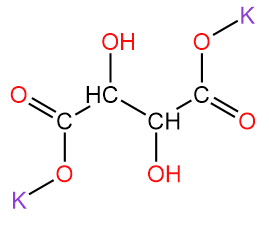
2. Potassium bitartrate/ potassium hydrogen tartrate/ cream of tartar with chemical formula KC4H5O6.
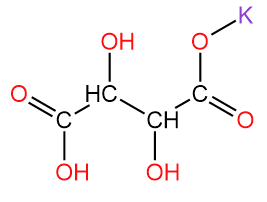
3. Potassium sodium tartrate tetrahydrate/ Rochelle Salt/ is a double salt with the chemical formula KNaC4H4O6.
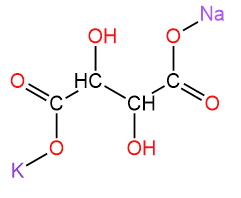
4. Antimony potassium tartrate/ tartar emetic with chemical formula K2Sb2(C4H2O6)2.
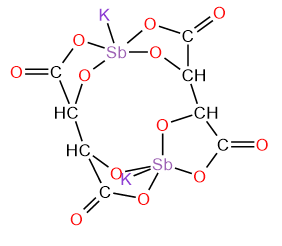
5. Diisopropyl tartrate is a diester of tartaric acid with the chemical formula C10H18O6.
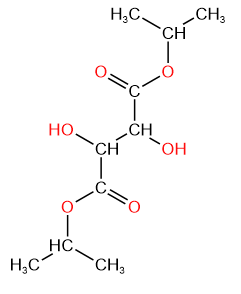
So, these are some examples of salts of tartaric acid and we can see that Antimony potassium tartrate is called tartar emetic. So, all the above answers are incorrect but since tartar emetic can be prepared by heating potassium tartrate with antimony oxide. Hence, the correct answer is Potassium Tartrate.
Thus, Option (C) is correct
Note: Antimony potassium tartrate is called tartar emetic because emetic means the medicine or any substance that causes the feeling of nausea and vomiting. It is toxic in nature but it is used to have an emetic effect and consumed in small quantities with wine.
Complete step by step solution:Tartaric acid is an organic acid and is a derivative of succinic acid. It contains two hydroxy groups and two carboxylic acid groups. There are several derivatives of tartaric acid like the salt of tartaric acid, cream of tartar (potassium bitartrate), Rochelle salt (potassium sodium tartrate), and tartar emetic (antimony potassium tartrate).
Structures of most common salts of tartaric acid-
1. Potassium tartrate/ dipotassium tartrate/ argol with chemical formula K2C4H4O6.

2. Potassium bitartrate/ potassium hydrogen tartrate/ cream of tartar with chemical formula KC4H5O6.

3. Potassium sodium tartrate tetrahydrate/ Rochelle Salt/ is a double salt with the chemical formula KNaC4H4O6.

4. Antimony potassium tartrate/ tartar emetic with chemical formula K2Sb2(C4H2O6)2.

5. Diisopropyl tartrate is a diester of tartaric acid with the chemical formula C10H18O6.

So, these are some examples of salts of tartaric acid and we can see that Antimony potassium tartrate is called tartar emetic. So, all the above answers are incorrect but since tartar emetic can be prepared by heating potassium tartrate with antimony oxide. Hence, the correct answer is Potassium Tartrate.
Thus, Option (C) is correct
Note: Antimony potassium tartrate is called tartar emetic because emetic means the medicine or any substance that causes the feeling of nausea and vomiting. It is toxic in nature but it is used to have an emetic effect and consumed in small quantities with wine.
Recently Updated Pages
Difference Between Alcohol and Phenol: Structure, Tests & Uses

Class 12 Chemistry Mock Test Series for JEE Main – Free Online Practice

Electricity and Magnetism Explained: Key Concepts & Applications

JEE Energetics Important Concepts and Tips for Exam Preparation

JEE Isolation, Preparation and Properties of Non-metals Important Concepts and Tips for Exam Preparation

JEE Main 2021 July 25 Shift 1 Question Paper with Answer Key

Trending doubts
JEE Main 2026: Application Form Open, Exam Dates, Syllabus, Eligibility & Question Papers

Derivation of Equation of Trajectory Explained for Students

Hybridisation in Chemistry – Concept, Types & Applications

Understanding the Angle of Deviation in a Prism

How to Convert a Galvanometer into an Ammeter or Voltmeter

JEE Main Marking Scheme 2026- Paper-Wise Marks Distribution and Negative Marking Details

Other Pages
Solutions Class 12 Chemistry Chapter 1 CBSE Notes - 2025-26

NCERT Solutions For Class 12 Chemistry Chapter 1 Solutions - 2025-26

The D and F Block Elements Class 12 Chemistry Chapter 4 CBSE Notes - 2025-26

NCERT Solutions for Class 12 Chemistry Chapter Chapter 7 Alcohol Phenol and Ether

NCERT Solutions ForClass 12 Chemistry Chapter Chapter 8 Aldehydes Ketones And Carboxylic Acids

JEE Advanced Marks vs Ranks 2025: Understanding Category-wise Qualifying Marks and Previous Year Cut-offs




